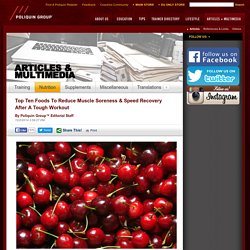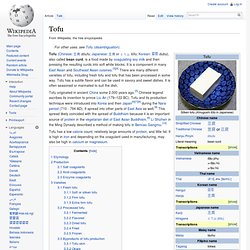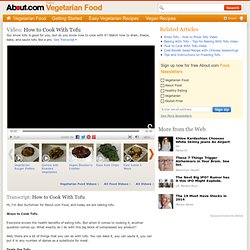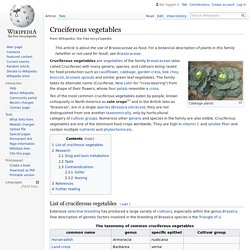

Top Ten Foods To Reduce Muscle Soreness & Speed Recovery After A Tough Workout. Sometimes a little muscle soreness can be pleasant: You worked hard and reached a new level of athleticism or strength.

But when the soreness gets severe, it can become a big ol’ pain in the gluteus maximus. A lot of people make the mistake of dismissing recovery as something that’s too complicated or that they don’t have tine for. They think of long, painful ice baths, massages that they really can’t afford, and ibuprofen or other NSAIDs that have side effects. In fact, the most effective ways to accelerate recovery and reduce muscle soreness is with food. By using a few simple (and delicious) nutrition strategies you can target multiple systems in the body that get beat down by training. For example, drinking caffeinated coffee can accelerate recovery by both reducing muscle soreness and restoring CNS function so you recuperate strength faster after an intense workout. #1: Eat blueberries, tart cherries, and other dark-colored fruit to reduce DOMS.
10 Secrets for Ending Your Sugar Cravings For Good. Are visions of chocolate bars stopping you from focusing on a task?

Or maybe, despite your best efforts to distract yourself, you’re obsessing over those donuts in the employee kitchen? First, the bad news: You may be addicted to sugar. Food Nutrition Facts - Healthy Living Tips at WomansDay. Every child has heard the healthy-eating mantra "You are what you eat.

" But there may be a closer resemblance between good-for-you grub and your body than you thought. We found 10 foods that mirror the body parts they provide nutrients for—for example, brain-boosting walnuts actually look like a brain. Coincidence? Maybe. Though these healthy foods are beneficial to the whole body, the list below is a fun reminder of what to eat to target specific areas. 1.
Slice a carrot in half crosswise and it's easy to see that the veggie resembles an eye—look closely and you'll even notice a pattern of radiating lines that mimic the pupil and iris. 2. The folds and wrinkles of a walnut bring to mind another human organ: the brain. The Glycemic Index. Tofu. Tofu has a low calorie count, relatively large amounts of protein, and little fat.

It is high in iron and depending on the coagulant used in manufacturing, may also be high in calcium or magnesium. Etymology[edit] The English word "tofu" comes from the Japanese tōfu (豆腐), which itself derives from the Chinese dòufu (豆腐 or 荳腐) from "bean" (豆) plus "curdled" or "fermented" (腐).[11][12][13] The term "bean curd(s)" for tofu has been used in the United States since at least 1840. It is not frequently used, however, in the United Kingdom, Australia or New Zealand.[15] Production[edit] Tofu is made by coagulating soy milk and pressing the resulting curds.
Salt coagulants[edit] Tofu - How to Cook With Tofu Video. You know tofu is good for you, but do you know how to cook with it?

Watch how to drain, freeze, bake, and saute tofu like a pro.See Transcript Hi, I'm Ben Kurtzman for About.com Food, and today we are talking tofu. Ways to Cook Tofu Everyone knows the health benefits of eating tofu. Food cravings... Cruciferous vegetables. This article is about the use of Brassicaceae as food.

For a botanical description of plants in this family (whether or not used for food), see Brassicaceae. Cruciferous vegetables are vegetables of the family Brassicaceae (also called Cruciferae) with many genera, species, and cultivars being raised for food production such as cauliflower, cabbage, garden cress, bok choy, broccoli, brussels sprouts and similar green leaf vegetables. The family takes its alternate name (Cruciferae, New Latin for "cross-bearing") from the shape of their flowers, whose four petals resemble a cross.
List of cruciferous vegetables[edit] Extensive selective breeding has produced a large variety of cultivars, especially within the genus Brassica. What is wheat germ. Protein - what is protein and why is it important for good health. What is protein?

Protein is found in every cell, muscle and tissue of our body and is also present in many of the foods that we eat. The protein in our body is essentially the same as the protein in our food, except that it is structured differently. Spread the word, share this on your social networks! Basically proteins are made up of long chains of amino acids. There are 22 different types of amino acid and the body needs all of them to function properly. Amino acids are chemical compounds containing carbon, hydrogen, oxygen and nitrogen, which combine together into different structures to form the various types of protein that the body requires. There are many forms of protein, which all play an important role in the function of the body. Essential and non-essential amino acids The 22 types of amino acid are divided into two groups: essential and non-essential amino acids.
There are 14 non-essential amino acids. Complete and incomplete proteins. Food Comparison. Olives: How Healthy are They? Which Olives are Best?